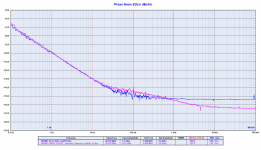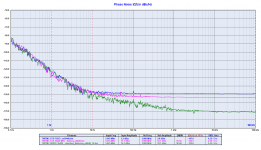Its all in how you use the devices. BJT current driven are pretty linear. Mosfet transfer curve is voltage driven and quite linear.
As Scott mentioned its possible to build simple circuits with extreme linearity using these devices and no feedback. There are other considerations that lead to more complex circuits and need for feedback.
Demian,
the curves of the anodic characteristic of the 45 are practically equidistant.
It's not so for BJT and mosfet.
In the curves you published you can clearly see a difference in the distance between the various curves, and this means less linearity.
This means that if you use a BJT or a mosfet without feedback you will get more distortion than the valve which has better intrinsic linearity.
Indeed as far as I know there are very few open-loop zero feedback power amps.
You should know what problems since you wrote "those were fixed too"
I see. Don't tell us then.
It's not true, the kind of signal sine or square and the amplitude don't matter.
The plots I have published about the noise of the picogates clearly demonstrate that the close in phase noise is not altered by the kind of signal and by the amplitude.
The picogate have been used to square the sine output of the oscillator and the close in phase noise is almost identical.
I wasn't referring specifically to you Andrea, but in general and actual hardware implementation in one's home.
You know the requirements for converters as well as comparators etc etc dictate a minimum speed requirement, otherwise jitter goes up.
Same goes for e.g. the ltc6957, the plots are very clear, see attached (pecl plot).
Last but not least, I'm pretty sure high speeds as well as proper routing and termination aren't tested at all in the diy-community. So adding a good clock with rather steep edges might even do more harm than good. If you catchy drift.
Attachments
Last edited:
May I ask, who's "we"?
Me and my co-developer, a pair of audio hobbyists who are trying to build a no-compromise audio system for ourselves.
We have virtually no budget limit, we have no commercial interests, so we can build what we believe in.
Of course, we have our beliefs, right or wrong, and so we follow our own way, without market and fashion conditioning.
I wasn't referring specifically to you Andrea, but in general and actual hardware implementation in one's home.
You know the requirements for converters as well as comparators etc etc dictate a minimum speed requirement, otherwise jitter goes up.
Same goes for e.g. the ltc6957, the plots are very clear, see attached (pecl plot).
Last but not least, I'm pretty sure high speeds as well as proper routing and termination aren't tested at all in the diy-community. So adding a good clock with rather steep edges might even do more harm than good. If you catchy drift.
I have tested the LTC6957 (plots attached), the results are the same of the picogates, they don't add close in noise.
We know that every component of the audio chain and also external factors can affect the jitter.
That's the reason we are building a FIFO buffer where the dirty signals are strong isolated from the crucial signal for the DAC (the LRCK for our discrete DAC).
Our target is two fully isolated time domains, so nothing can affect the conversion.
Attachments
It's easy to find out if certain amp is transparent or not with input and output components by studying the specs.One could also say tube amps sound better because they euphonically add more "weight" to the sound and by that coincidentally make for a better House Curve.
It's impossible to state a certain amp will be transparent or more true, in a complete audio set, on the basis of thd-numbers.
That's not true at all.Nobody in this forum, possibly excepting Jakob2, is an expert in human perceptual testing.
IMO, of course.
How would you compare specs when e.g.
Amp A has -70dB 2nd, -100 3rd Rout = 0,4 ohm
Amp B has -100 dB 2nd, -85 3rd, -95 5th Rout= 0,02 ohm
How do you weigh these numbers so a valid comparison can be made on paper? I sure as hell can't.
In the mix: the speaker is a d'appolito or 2,5 way: around 3 ohm in the lower frequencies, around 8 at the higher ones.
Edit: another mix: a typical non segmented ESL with around 1 ohm or so at 20KHz.
Amp A has -70dB 2nd, -100 3rd Rout = 0,4 ohm
Amp B has -100 dB 2nd, -85 3rd, -95 5th Rout= 0,02 ohm
How do you weigh these numbers so a valid comparison can be made on paper? I sure as hell can't.
In the mix: the speaker is a d'appolito or 2,5 way: around 3 ohm in the lower frequencies, around 8 at the higher ones.
Edit: another mix: a typical non segmented ESL with around 1 ohm or so at 20KHz.
Last edited:
How would you compare specs
Compare specs, to what end? Otherwise, just put them in two columns and you'll have a side by side comparison. "Which one is better" is not a valid answer.
Me and my co-developer, a pair of audio hobbyists who are trying to build a no-compromise audio system for ourselves.
We have virtually no budget limit, we have no commercial interests, so we can build what we believe in.
Of course, we have our beliefs, right or wrong, and so we follow our own way, without market and fashion conditioning.
Your LinkedIn professional profile tells a slightly different story: "Progettazione e realizzazione Audio Alta Fedeltà" (among others).
Compare specs, to what end? Otherwise, just put them in two columns and you'll have a side by side comparison. "Which one is better" is not a valid answer.
Yet in post 917 you used it to claim the difference between High Fidelity, transparent amplifiers and an effect box. I was only wondering where is the line in the sand that makes one amp an effect box and the other transparent, if all one has is thd numbers, measured in total isolation from real loads, acoustics etc?
I say we can't define a clear line. Same goes for phase noise.
Perhaps not a perfectly sharp line, but the limits of audibility for frequency response, distortions, etc... are well known for over 50 years. When in doubt, the “extraordinary claim requires extraordinary proof” principle applies. So is the phase noise effect, everybody claims it can hear it (at various levels) but nobody cares to show any data about. The effects of jitter/phase noise on the data conversion process are well understood, are clearly measurable, and are orders of magnitude under any audibility limits, though some keep talking about effects impacting GBPS conversion at GHz frequencies. These make all the claims “extraordinary” and should be treated accordingly.
The same sort of extraordinary claim BS was made about people who can hear if CDs are left undithered. ESS has already found that audiophiles can audibly tell an SD dac from an conventional dac. They found that some people can hear noise floor modulation. Purifi found that people can hear hysteresis distortion in class D amps. The list goes on and on.
Actually, what is an extraordinary claim is that nobody can hear such things.
Actually, what is an extraordinary claim is that nobody can hear such things.
To all,
Please take member SYN08's remarks not to «heavily», it is well know on this forum he has a tendency to question about everything, especially characteristic of objects and beings to simply exist. If such existential questions suits you, you'll find a friend, otherwise you could very well be wasting your time.
Just wanted to let you guys know 🙂
Please take member SYN08's remarks not to «heavily», it is well know on this forum he has a tendency to question about everything, especially characteristic of objects and beings to simply exist. If such existential questions suits you, you'll find a friend, otherwise you could very well be wasting your time.
Just wanted to let you guys know 🙂
How would you compare specs when e.g.
Amp A has -70dB 2nd, -100 3rd Rout = 0,4 ohm
Amp B has -100 dB 2nd, -85 3rd, -95 5th Rout= 0,02 ohm
Purely personally I'd reject both, not because there are likely to be audible, but because it's fairly easy to get much better these days.
And yet peer reviewed analysis shows an exceedingly poor correlation.ESS has already found that audiophiles can audibly tell an SD dac from an conventional dac.
[ Purifi found that people can hear hysteresis distortion in class D amps.
Nope, that is twisting words to meet your beliefs. Nothing in the Purifi white papers suggest they did any testing on the audibility.
The same sort of extraordinary claim BS was made about people who can hear if CDs are left undithered. ESS has already found that audiophiles can audibly tell an SD dac from an conventional dac. They found that some people can hear noise floor modulation. Purifi found that people can hear hysteresis distortion in class D amps. The list goes on and on.
Actually, what is an extraordinary claim is that nobody can hear such things.
Please quote citations for your statements about. I am not aware of any serious study showing that there is no perceptual difference between dither/undither.
And please note that no study can show that “nobody can hear” but only with a certain probability.
And yet peer reviewed analysis shows an exceedingly poor correlation.
Not everybody is good at it, a few are.
Nope, that is twisting words to meet your beliefs. Nothing in the Purifi white papers suggest they did any testing on the audibility.
In an interview with Bruno and Lars, the story they gave was that Lars first noticed the hysteresis effect audibly. He thought it sounded similar to some magnetic distortion in speaker drivers he was working on. That led Bruno to look for the cause. Bruno said he did nothing to fix it until he understood the math well enough, then he implemented changes to fix it. After that they decided to talk about it. Why then? My guess would be because they saw it as a competitive advantage to go public with it. I wouldn't be surprised if there are other issues they know about that Bruno hasn't figured out the math for.
Regarding the dither/no-dither issue, Scott Wurcer said it is uncontroversial - some people can hear it.
The term high fidelity in amplification means the output signal's faithfulness to input signal to high degree. Today's typical solid state amps on the mainstream market meet such demand audibly. If you aren't sure what that means, look up the specs and measurements under load.Yet in post 917 you used it to claim the difference between High Fidelity, transparent amplifiers and an effect box. I was only wondering where is the line in the sand that makes one amp an effect box and the other transparent,
If this is about audio equipment, listening test would be the defining criteria for its performance, no?I say we can't define a clear line. Same goes for phase noise.
Please quote as that is NOT what the interview I read said.In an interview with Bruno and Lars, the story they gave was that Lars first noticed the hysteresis effect audibly.
- Home
- Source & Line
- Digital Line Level
- AK4499EQ - Best DAC ever


